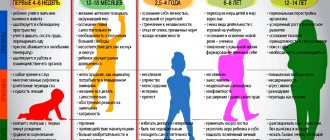Baby's needs
In the first days after childbirth, the mother secretes colostrum - a thick yellowish liquid. Colostrum is extremely rich in vitamins, but most importantly - immunoglobulins and other immunoprotectors, which will populate the baby’s sterile intestines and will provide protection for the body from birth until it develops its own immunity.
On the 4th – 5th day, the mother begins to produce “transitional” milk. The baby, although just a little, has already grown up, his needs have changed, and with them so has the milk: it contains more fat and carbohydrates, and less protein.
By the end of the 2nd week, “mature” milk appears. It contains the least protein (compared to colostrum and transitional milk).
Breastfeeding and formula feeding. Let's compare?
“The most profitable investment is investing milk in a child.”
W. Churchill
The difference between human milk and its substitutes (animal milk, nutritional formula)
You often hear phrases like:
“Well, in the grand scheme of things, what’s the difference, breast or mixture? These are such good mixtures now!”
“Cow's milk is so rich and nutritious! It’s no worse than human milk,” etc., etc.
Is it really that simple? Isn't there, by and large, no difference whether a child drinks mother's milk or cow's milk? Let's figure it out.
The most important and fundamental difference: human milk is a “living” substance. Unlike formula, which has a stable composition, the composition of mother's milk is constantly changing in response to the changing needs of the baby depending on his age, health, frequency of breastfeeding, and even the time of day or climate in which the baby lives.
The best modern formulas contain about 50 components, and breast milk contains more than 1000, ideally balanced just for your baby! Most of them cannot, in principle, be synthesized artificially. And these are just those that are open today, not all!
The composition of milk, in addition to proteins, fats, carbohydrates and water, includes all the vitamins and enzymes necessary for the child, which are responsible for the successful absorption of any portion of human milk.
More than 700 species of bacteria have been found in human milk. Moreover, the bacterial composition is different at different periods of feeding. The role of the breast milk microbiome has yet to be studied in detail, but it is already clear that it is extremely important for the normal development of the child. Bacteria help absorb milk components, participate in the formation of microflora and help develop the child’s immunity.
All components of breast milk are in bioavailable form, that is, they are easily digested and fully used. For example, there is not much iron in human milk, but it is well absorbed - up to 50%, compared to 20% from adapted artificial formulas and only 10% from whole cow's milk. Therefore, it is extremely rare for breastfed children to develop iron deficiency anemia.
Breast milk calcium is absorbed most efficiently due to the optimal ratio of calcium to phosphorus (2: 1), which is not observed either in cow's milk or in artificial formulas.
Breast milk contains more than 15 hormones, which are not and cannot be in artificial formulas, because artificially synthesized hormones, even in the smallest concentration, are medicine.
Immunoglobulins (in particular, immunoglobulin A) in breast milk protect the surfaces of the mucous membrane of the gastrointestinal tract and respiratory tract and thereby reduce the risk of infections several times, and also create a favorable environment for the colonization of the gastrointestinal tract with beneficial bacteria and suppress the growth of pathogenic flora . For example, lactoferrin binds iron, thereby depriving pathogenic bacteria that consume iron of a favorable environment for reproduction in the gastrointestinal tract. And this is just one of the functions of this amazing protein.
The concentration of protective immune factors in milk increases with the age of the child and with a reduction in the number of feedings, thus, children who are fed after one year continue to receive strong immune support.
Breast milk contains enzymes (lysozyme, lipase, amylase, etc.) that are activated in the baby’s gastrointestinal tract and help the immature digestive system process milk. Milk digests itself, thereby reducing the load on the child’s immature gastrointestinal tract!
And back in 2013, scientists released research data confirming that about 30% of all human milk cells are stem cells and, like any stem cell, can turn into cells of the heart, bone tissue, pancreas and brain! That is, a baby who receives mother’s milk receives not only nutrition, but also cells that can contribute to the regeneration of any body tissue!
Breast milk protects against infections by passing on specific immune cells from the mother to the baby. That is, a sick mother, feeding her child, does not transmit viruses to him, but ready-made immunity from this virus. And vice versa: if a child gets sick, then as soon as the virus with saliva enters the mother’s breast, the body begins to produce antibodies and by the next feeding the milk already contains “medicine” for the baby.
In the stomach of a breastfed baby, a complex of alpha-lactalbumin (whey protein from breast milk) and oleic acid is formed, which has an anti-cancer effect. This complex was called HAMLET (abbreviation). It causes the death of cancer cells without harming the rest of the body's cells!
Human milk is intended for the growth of the human baby. The fat composition of breast milk primarily supports brain development by supplying essential substances for the production of myelin, the fatty sheath that surrounds nerve fibers, insulating them so that information can travel through them.
Cows, for example, give their calves milk that is high in proteins for rapid body growth, but cow's milk contains low levels of the nutrients needed for rapid brain growth (by the way, most formula is made from cow's milk).
Mature human milk has the lowest protein content of all other mammals, which reduces the burden on the kidneys and, as a result, reduces the risk of obesity and diabetes. That is, it contains exactly as much protein as a human baby needs, and not a calf or kid.
Human milk contains more lactose (the main carbohydrate in milk) than milk produced by any other animal (including 20-30% more than cow's milk). It is of great importance for the development of the central nervous system, improves the absorption of calcium and iron, stimulates the formation of intestinal colonies of Lactobacillus bifidus - beneficial microflora that suppresses the growth of pathogenic bacteria.
And finally, breastfeeding is just very convenient. This is both food and drink! It's so simple: pick up your baby and put him to your breast. At home, on the road, traveling or visiting. You don’t need to think about where to heat the water, dilute the mixture, wash the bottle, and where to put the remains of the unused mixture. And it's absolutely free :-).
This is far from a complete list of the truly amazing properties of human milk. And how many more of them do we still know nothing about!..
Risks of artificial feeding
Breastfeeding, in contrast to artificial feeding, ensures an optimal ratio of fat and muscle tissue in the child’s body and an optimal ratio of body length and weight.
Breastfeeding, unlike formula, is almost impossible to overfeed, since the child regulates his own nutritional needs, and does not drink “as much as he was given and when he was given,” remaining a passive participant in the feeding process. In addition, breast milk contains hormones (leptin and adiponectin) that are responsible for the feeling of fullness. Naturally, they are not in the mixture. Formula-fed children are more likely to suffer from obesity and metabolic syndrome during adolescence. The longer the period of breastfeeding, the greater the risk of becoming overweight in the future is reduced.
Already at 4 months, in bottle-fed children, the size of the thymus gland (the thymus gland, which is responsible for immunity) is significantly smaller than in mixed-fed and, especially, breast-fed children. Long-term studies confirmed (2005-2012) that at the age of 6 years, breastfed children were significantly less likely to visit doctors for ear, nose and throat diseases. Also, the total number of visits to doctors was lower the longer the child was breastfed.
Artificial feeding increases the risk of developing allergies not only in the first year of life, but also in the future. This is especially important for children whose parents suffer from allergies.
The intestines of a newborn child are functionally immature and have increased permeability. Potential allergens can easily penetrate the intestinal wall into the bloodstream. Only after a few months the mucous membranes will become mature enough to protect the child’s body from the penetration of foreign proteins and pathogenic flora. The protective factors of milk literally line the intestinal walls, taking on this protective function in the first months. Artificial nutrition, unlike breast milk, does not provide a reliable protective coating for the gastrointestinal tract. This is one of the reasons for more frequent cases of allergies in bottle-fed children. The mixture itself is a risk factor due to the presence of proteins foreign to humans. If there is a hereditary tendency to allergies, even one feeding with formula may be enough for the child to develop intolerance to cow's milk protein.
Also, children on IV have a significantly higher risk of developing atopic dermatitis.
Artificial feeding increases the risk of gastrointestinal diseases. Children who are not exclusively breastfed are 46% more likely to have gastrointestinal illnesses in the first 6 months of life. But even if the child gets sick, infants are less likely to experience dehydration and gain weight faster than bottle-fed ones.
Children who are not exclusively breastfed are 27% more likely to have an upper respiratory tract infection in the first 6 months of life.
There is strong evidence that formula feeding increases the risk of pneumonia, especially in the first months of life. Formula-fed babies are 17 times more likely to be hospitalized for pneumonia than breastfed babies.
Also, a number of studies have confirmed an increased risk of middle ear inflammation (otitis) in formula-fed children.
In the process of sucking the breast (as opposed to sucking the pacifier), almost all facial muscles are involved, the child performs a whole range of various movements. This ensures the correct formation and development of the maxillofacial apparatus. In artificially fed children, malocclusions are significantly more common.
Artificial feeding increases the risk of developing leukemia. According to research, children who were breastfed for less than 6 months have a 14-19% higher risk of leukemia.
There is evidence to suggest that artificial feeding increases the risk of Crohn's disease and ulcerative colitis.
Feeding formula to premature babies seriously increases the risk of developing necrotizing enterocolitis, worsens the development of the nervous system, and increases the risk of child disability, in particular, the development of retinopathy of prematurity (in some cases, premature babies may need breast milk fortifiers for a certain period).
Benefits of breastfeeding for mom
Main! Lactation is a natural part of the female reproductive cycle, along with ovulation, menstruation, pregnancy and childbirth. Changes in hormonal levels, the shape and structure of the breast, and the absence of menstruation in themselves cannot be the cause of pathological conditions in the mother’s body without the presence of true causes and risk factors for the development of any diseases.
Breastfeeding helps a mother recover faster after childbirth. The baby's suckling of the breast causes an increase in the level of the hormone oxytocin, which causes the uterus to contract and quickly return to the size it had before pregnancy. This is why many mothers experience a pulling sensation in the lower abdomen during feeding in the first days.
Mom spends about 500-700 additional calories daily to produce milk. Thus, even by slightly increasing the amount of food you eat, you still continue to gradually lose excess weight.
Prevention of osteoporosis. Research shows that women who have not breastfed at all are four times more likely to develop osteoporosis in later life. Women who breastfed are less likely to experience hip fractures after menopause.
Prevention of cardiovascular diseases in older age. A study of almost 300 thousand women confirmed that breastfeeding every 6 months reduces the risk of heart disease by 3-4%.
Protection against hypertension. Women who have never breastfed have a one and a half times higher risk of hypertension than women who have breastfed for at least 12 months. The longer the period of breastfeeding, the greater the protective effect (meta-analysis of 7 studies involving almost 445 thousand women).
Cancer protection. After a series of studies, in 2013, Australian scientists published data that women who gave birth to three children and breastfed for a total of at least 31 months, the risk of developing ovarian cancer is reduced by 91%. Any mother who nursed her baby for more than 13 months was 63% less likely to have ovarian cancer (the fifth leading cause of death in women).
Another study found that among women who have the BRCA1 gene (which means they have a 75% chance of getting breast cancer), breastfeeding for at least a year reduces the risk of the disease by 32%. Feeding is practically the only option for prevention. And each subsequent year of breastfeeding reduces the incidence of cancer for this group by another 19%.
One of the explanations for the fact that breastfeeding is such an effective prevention of cancer was found in 2013 by Novosibirsk scientists. They discovered a protein in human milk that causes the death (apoptosis) of tumor cells, including malignant cancer cells. The effect of lactaptin is comparable to modern methods of chemotherapy, and at the same time devoid of its disadvantages - this protein is absolutely non-toxic and safe, acting selectively only on diseased cells! What's surprising is that lactaptin in breast milk seems to be primarily responsible for the health of the mother.
Protection against diabetes. Gestational diabetes mellitus develops in some women during pregnancy. For most women it goes away after childbirth, but for some it immediately turns into type 1 or type 2 diabetes. There is also a risk of developing diabetes several years after giving birth. Canadian scientists conducted a large-scale study, which found that those mothers who breastfed for 10 months or longer passed insulin tests with significantly better results than those who breastfed for less than 10 months or did not breastfeed at all. The researchers concluded: The longer a woman with gestational diabetes breastfeeds, the lower her risk of developing further insulin resistance and developing chronic diabetes!
Natural contraception (lactational amenorrhea). The same hormones that produce milk suppress the onset of ovulation when breastfeeding is properly organized.
IMPORTANT! According to WHO, the reliability of this method is up to 98% in the first months with exclusive breastfeeding, but the possibility of pregnancy exists! A woman can become pregnant several weeks before her first period (during her first ovulation).
Breastfeeding is good not only for the mother's body, but also for the soul. The same hormone that promotes milk production (prolactin) helps the mother feel calm. Prolactin is known as one of the stress-fighting hormones, and studies have shown that breastfeeding mothers are less likely to develop postpartum depression.
And, finally, breastfeeding is a unique connection between mother and child, amazing mutual understanding and harmony in relationships. Breastfeeding, the mother gives the child a sense of security, stability, basic trust in the world and in others.
Instead of an afterword
So is it even possible to compare feeding a newborn with milk from the mother’s breast and an artificial formula?
Breastfeeding ensures the normal, natural development of this particular child. This does not mean that the child will be a genius, will not get sick and will grow up incredibly beautiful; this means that the child has a very good chance of maximizing the potential inherent in him by nature. With artificial feeding, these chances are greatly reduced.
Yes, there are times when, for some reason, breastfeeding is undesirable or impossible. But artificial feeding is not a normal option; it is a necessary measure for the survival of a baby, for one reason or another, deprived of a natural way of feeding.
Human milk is the NORMAL complete nutrition for a baby during the first 6 months.
and a very important and valuable part of a baby’s diet in the first years of life.
Just think about the words that we pronounce automatically: natural feeding - artificial feeding...
However, breastfeeding your child is a woman’s right, not her responsibility. If a mother, for some (any!) reason, decides not to breastfeed, she has the right to count on the understanding and support of her loved ones. Whether a mother is breastfeeding or bottle-feeding, she is still the best mother to her baby and has a million ways to show love and care for her baby other than breastfeeding.
Melnikova Rada, breastfeeding consultant
Sources:
1. National program for feeding children in the first year of life. Moscow, 2021
2. WHO “Feeding and nutrition of infants and young children”, Copenhagen, 2003.
3. W. Sears, M. Sears “Breastfeeding”
4. Materials of the training course for breastfeeding consultants under the WHO/UNICEF “Mama City” program https://mama-city.ru/
5. Materials of the advanced training course “New Level” https://www.new-degree.ru/
6. La Leche League materials https://www.lllrussia.org/
7. The human milk microbiota plays a role in health of the infant https://www.infantrisk.com/content/human-milk-microbiota-plays-role-health-infant-0
8. Bacteria in breast milk https://milkmama.info/info/49/bakterii-v-grudnom-moloke.html
9. HAMLET complex, derived from breast milk, kills cancer cells. https://gvinfo.ru/node/197
10. A study found that breastfeeding can prevent up to 19% of cases of childhood leukemia. https://sppm.su/issledovanie-pokazalo-chto-grudnoe-vskarmlivanie-mozhet-predotvratit-do-19-sluchaev-detskogo-leykoza 11. Optimal feeding of children with low birth weight. Technical review, WHO, 2006
12. Breastfeeding and the risk of maternal cardiovascular disease: A prospective study of 300,000 Chinese women https://jaha.ahajournals.org/content/6/6/e006081 13. Breastfeeding against hypertension https://new-degree. ru/gvinform/hypertension/ (https://www.ncbi.nlm.nih.gov/pubmed/29698055)
14. World Health Organization. Long-Term Effects of Breastfeeding: A Systematic Review. WHO: Geneva, Switzerland. -2013. https://apps.who.int/iris/bitstream/handle/10665/79198/9789241505307_eng.pdf?sequence=1
What does breast milk consist of?
Milk is 87% water, the remaining 13% is protein (1%), fat (4%), carbohydrates (7%) and vitamins and microelements (about 1%). Macronutrients
- Squirrels. It is a building material and a basis for growth. From the proteins that come with breast milk, hormones are synthesized in the baby’s body, antibodies are produced, and thanks to them, immunity is formed. Proteins are very important in the first year of a child’s life, because at this time the baby grows very rapidly. Breast milk consists of proteins (and they are made of amino acids). When food enters the body, it is broken down into amino acids, which are building materials for the human body. One of these “building blocks” is taurine, which promotes the development of the brain and nervous system. Another of them - casein - is more difficult to digest, but in women's breast milk, unlike cow's milk, there is very little of it;
- Fats are an essential component of a baby's diet. They are part of cell membranes and participate in the formation of the nervous system, which makes them indispensable during the growth period of the baby, and that is why breast milk is relatively fatty. Cholesterol, also one of the components of breast milk fats, is necessary for brain development and is involved in the synthesis of hormones and vitamin D. Breast milk fats are easily absorbed by the child’s body. The greatest amount of fat is contained in “hind” milk, so breastfeeding experts recommend that a nursing mother ensure that the baby empties the breast during one “meal”, otherwise he will receive “front” milk, which serves more as a drink for the baby than food. The fat content in milk changes both during the day (increases in the evening) and throughout the entire period of feeding (decreases as the child grows). The total amount of fat in breast milk is not regulated by diet, but the mother’s diet affects the qualitative composition of fatty acids acids;
- Carbohydrates. The main function of carbohydrates is to provide energy to the body. They are represented in mother's breast milk by lactose - milk sugar. Lactose is broken down in the intestines into the enzymes glucose and galactose, which are involved in the absorption of calcium. Glucose is especially in demand by the brain, for whose activity it is vital.
Nucleotides contained in breast milk are the basis for the construction of DNA, so they are very important during the period of intensive growth of the baby. Micronutrients
- Minerals. All necessary minerals and vitamins are contained in mother's milk. Moreover, they are in ideal form for absorption by the baby’s body. Until one year of age, a child receives everything he needs from his mother’s milk. Only a mother should not forget that the quality and composition of her milk depends on how she eats;
- Immunologically active substances. The baby does not yet produce immune cells and antibodies on its own, but receives them through mother’s milk. Mother's milk is the ideal food for a baby in the first year of life. Its composition is characterized by a balance of nutrients, enzymes, hormones, immune factors and other components. It contains complete proteins in optimal quantities and ratios, with the help of which vitamins, hormones and other physiologically active substances are transported. Remember: breast milk is the best nutrition for your babies. But if choosing infant formula becomes a necessity, be sure to take into account the age recommendations indicated on the packaging. Also, before first use, you should consult a pediatrician.
Remember: breast milk is the best nutrition for your babies. But if choosing infant formula becomes a necessity, be sure to take into account the age recommendations indicated on the packaging. Also, before first use, you should consult a pediatrician.
Other benefits for the child
Long-term breastfeeding is considered the best way to maintain closeness between mother and baby. The benefit of this is obvious: psychologists say that it is precisely those children who were on breastfeeding, who were more often picked up, who grow up to be more mature and formed individuals without complex social problems. What other advantages do long-term feeding have?
- Up to one and a half to two years, being in the arms of the mother, the child feels safety and protection. This helps him grow up to be a confident, calm and balanced person.
- GV reduces the risk of developing allergic reactions, especially food ones.
- Nutrients contained in abundance in breast milk help the normal formation of the nervous and cardiovascular systems.
- Human milk contains substances that relieve pain during teething.
Some opponents of long-term feeding believe that it harms the formation of the bite: allegedly, with prolonged breastfeeding, the child’s maxillofacial muscles do not develop correctly. However, incorrectly selected pacifiers are more harmful to the bite. Another argument of “harm” is the development of caries in the child, since mother’s milk is sweet. Scientists, however, have concluded that the enzymes contained in human milk, on the contrary, have a beneficial effect on the baby’s tooth enamel.
Breast milk and the diet of a nursing mother
Breast milk is not just a set of macro- and micronutrients that a nursing mother passes on to her baby, but also what she eats herself. We write about this in the material “Diet of a Nursing Mother.”
That's the most important thing. Nutrition during breastfeeding, especially in the first weeks after childbirth, is not very varied: brown rice, green salad, spinach, sorrel, avocado, plain yogurt, kefir and cottage cheese (in moderation), oatmeal, eggs (in moderation if allergies are detected - they should be excluded), seasonal fruits and vegetables (the paler the color, the less allergenic they can be considered), buckwheat. As the baby grows, the list of allowed products gradually expands. The mother can introduce new foods in small portions and observe the baby’s reaction to them. It is better to do this in the first half of the day so as not to miss the symptoms of food intolerance.
Some foods should be completely excluded from the diet when breastfeeding a newborn: alcohol, coffee, strong tea, chocolate, milk, raw onions, garlic, citrus fruits, strawberries, shrimp, lobsters, Brussels sprouts and cauliflower, legumes, corn, bright varieties of pumpkin, melon , persimmon, mint, hot spices, tomatoes, peanuts. Some of them can cause food intolerance and allergies, others contribute to increased gas formation, which causes considerable discomfort for a baby with an immature digestive tract.
By paying attention to your diet, you protect your child’s growing body from unnecessary stress - allergies, indigestion, colic, constipation and diarrhea.
We advise you to keep a food diary in which you can record all the foods you eat during the day, as well as the time you eat. This is the perfect cheat sheet for finding out the possible causes of allergies in your baby.
Benefits for the mother
Breastfeeding after one year can be beneficial not only for the baby, but also for the mother. Some believe that during breastfeeding a woman cannot become pregnant, but this is not true. Already six months after giving birth (sometimes even earlier), a woman may begin to ovulate, that is, breastfeeding will not provide any contraceptive effect. So this is more of a myth than a reality. However, long-term feeding has other positive effects:
- the risk of developing cancer of the breast and reproductive system is reduced;
- Daily breastfeeding allows a woman to expend an additional 300–500 kcal per day, which helps her get back into shape faster after childbirth.
Of course, each woman must decide for herself whether she will continue breastfeeding after the child is one year old. However, you need to understand that giving up breastfeeding should be smooth. This is important not only for the child, but also for the mother. After all, this significantly reduces the risk of developing mastopathy: you don’t have to express milk, which often only leads to unnecessary trauma to the mammary gland. Of course, when the child starts teething, breastfeeding may be no less traumatic, but in this case the woman must decide for herself whether she should continue to breastfeed the child or gradually switch to formula.
We put the baby to the breast
Not all mothers know that to establish breastfeeding, experts advise putting the baby to the breast as early as possible, ideally immediately after birth. Breastfeeding babies for the first time is a very healthy and important step. It is believed that the baby should be in skin-to-skin contact with the mother for at least two hours after birth. Starting breastfeeding will help your baby adapt to the new environment, obtain the correct flora of the skin and mucous membranes, and maintain the necessary temperature balance. The beating of his mother’s heart, her warmth and affection will give him a feeling of calm. And the mother’s body receives a signal to increase the production of the hormones oxytocin and prolactin, which are responsible for a strong emotional connection with the newborn and milk production, respectively.
As a rule, the baby can latch onto the breast on its own within half an hour after birth. But don’t worry if the breastfeeding process cannot be established right away - in the first days after birth, both you and the baby have a lot to learn. Now both your bodies are adjusting to extremely important work, and this will take some time.
- If for some reason you cannot put your baby to your breast, use a breast pump: this will relieve tension from your swollen breasts and stimulate milk production;
- The baby must be in the correct position: among other things, this will help avoid cracks and abrasions on the nipples. You need to feed your baby in a comfortable position, in which you can comfortably sit for a long time. Some experts recommend feeding in a lying position so that the baby can “help” the mother. But there are nursing mothers who recommend other positions when breastfeeding. Try them all and choose the one that suits you;
- Gently hold your baby by turning him towards you. The entire nipple areola should be in the baby's mouth, the lower lip should be turned out, and the baby's chin and tip of the nose should rest against the mother's breast. This process may require time and patience;
- Offer your baby one breast first, and only if he is not full, the second. This will allow the baby to receive hind milk, which is rich in fat. In this case, it’s worth waiting until the child lets go - he will intuitively know when it’s time to finish. Let your son or daughter regulate the duration of feeding themselves, without limiting the time they spend at the breast. Over time, you will get used to it and will clearly know when to offer your newborn a second breast.
Breastfeeding after one year
Does a baby need breastfeeding after one year? Most researchers agree that it does. For example, scientists from the Department of Anthropology at the University of Texas, after analyzing the habits of primates, came to the conclusion that the optimal age for weaning a baby is from 2.5 years. However, this does not mean that you need to go to extremes! Overestimating the benefits of breastfeeding can lead to parents starting to introduce complementary foods into their children's daily diet too late. It is recommended to do this from 4–6 months, and by the age of one year the child should begin to develop the skills of chewing and swallowing solid food. Underestimation of the importance of breastfeeding leads to the fact that the child is weaned from the mother’s breast too early, believing that the milk has “become empty.” As mentioned above, this is absolutely not true, and breastfeeding after a year will also benefit the baby. If for some reason a woman cannot feed the child on her own, it is recommended to select specialized formulas that replace mother’s milk, for example Nutrilak Premium.
(53 ratings; article rating 4.6)
Share Share Share
Feeding rules
In order for feeding to be complete, you should seriously pay attention to it - even during natural breastfeeding on demand. And even more so, these rules apply to mothers whose children are bottle-fed, since in this case it is important to maintain a reasonable interval between doses of the formula.
- Sometimes restlessness and crying, which we take as signs of hunger, can be manifestations of the active phase of sleep - in this case, after a minute or two the child falls asleep again;
- If you understand that the baby is hungry, then, when you put the baby to the breast, make sure that he grabs the nipple and areola - this way air will not get to the baby along with the milk (loud smacking is a sign that the baby is sucking in air along with the milk );
- You must be calm and attentive, do not be distracted by other things, do not run, do not talk on the phone. Even if you are feeding your baby outside during the day, stop, sit on a bench and feel that there are only two of you in the whole world. Let this moment be permeated with magic and tranquility;
- Don't rush or stop your baby - let him eat as much as he sees fit. You have done your job - you have provided your child with a calm environment for eating and given him the best nutrition, breast milk or, if necessary, a suitable formula. Now it’s up to the baby himself, and no one but himself knows better how much food his body needs;
- If the baby is bottle-fed, feed the baby a little more slowly, the mixture should completely fill the nipple, you can use special bottles that do not allow air to pass along with the food;
- After feeding, hold your baby in an upright position for 2 to 5 minutes, with his head leaning against your shoulder and his tummy pressed closely to your chest;
- Massage will help remove gases from the baby's intestines. How to do it correctly, we write here;
- If the baby stops eating and turns away, this is probably a sign that he is full. But perhaps he is just resting before the next portion. Raise him in a “column” so that he burps, and after a minute or two again offer him food;
- It is very important not to take artificial breaks between feedings. It doesn't matter whether you feed on demand or on a schedule - the intervals between feedings should not exceed 2 - 3 hours. It is especially important for proper milk production not to skip night feedings - the peak action of the hormone prolactin, which is responsible for milk production, occurs in the early morning;
- Pumping can be useful for stimulating milk production, as well as during mother-to-baby weaning.
Hypoallergenic diets
In the context of the need to temporarily prohibit allergenic foods for nursing women, an interesting study was recently published (although, we emphasize once again, any work regarding maternal nutrition and the neonatal period in general requires additional evidence).
One hundred and twenty women taking part were divided into three groups:
- 40 of them ate a diet high in eggs;
- 36 - completely excluded this product from their diet;
- 44 — consumed it moderately.
After 6 weeks of the diet, as the results showed, in the first category, significant concentrations of ovalbumin, the main protein in egg white, were noted in breast milk, which correlated with a significant concentration of antibodies to it in the child’s body. This gave reason to assume the development of oral tolerance - that is, the absence of reactions (local and systemic) from the immune system to a specific antigen supplied with food - a foreign substance.
Study
: Effects of Maternal Dietary Egg Intake During Early Lactation on Human Milk Ovalbumin Concentration: A Randomized Controlled Trial
In general, many scientists are inclined to believe that there is a so-called critical window - this is the first 1000 days of a baby’s life, during which the immune mechanisms are adjusted. It is believed that external influence on key links during this period can lead to a significant reduction in the risks of allergic diseases.
Of course, the first acquaintance with allergens occurs in the mother’s body - in particular, they can also be microbial foreign patterns. Then, after birth, immunocompetent cells continue to encounter various antigens - all this should ultimately lead to a clear distinction between “self” and “foreign”.
The results of a study of those babies who adhered to artificial feeding are noteworthy - in particular, the preventive effect of hypoallergenic formulas (based on protein hydrolysates) was also noted. Thus, children born from parents with allergies (and therefore at a fairly high risk) and during the first six months of their life received a partially hydrolyzed mixture (that is, the protein molecules in which were already “cut” into smaller fragments, which significantly facilitated the process of digestion and absorption), at 6 months and at 3 years they had absolutely identical IgE indicators (antibodies directly involved in the development of allergic (anaphylactic) reactions of the first type) with babies who were fed standard formulas.
We recommend
“Psychology of stress: types, stages, ways of dealing with it” Read more
However, it must be said that newborns on a hypoallergenic diet had higher levels of T cells - an indicator of oral tolerance.
Both studies cited in our article are contradictory. Perhaps the truth really lies somewhere in the middle. However, given the scale and duration of the research necessary for an accurate determination, this will not become known soon.
Is your baby getting enough milk?
Don't worry, it's not that difficult to figure out. Usually, a baby who is full will let go of the breast on his own. At this moment, do not rush to immediately move on to other things - stay together for a while. Carry your baby in a column, sing him a song, read a nursery rhyme, do finger exercises. If the baby does not demand the continuation of the banquet, then he is full and satisfied and the meal is over.
If your baby's weight gain is a concern, weigh your baby before and after feedings on a baby scale and record how much his weight has increased.
In the first time after birth, the baby should receive the breast about 10 times a day, stay with it as long as he needs, and also suck milk effectively. Then the baby should not have problems with weight gain. Of course, we are talking about “ideal” conditions when the child lives in comfort, surrounded by love and care: he takes walks in the fresh air with his mother, gets enough sunlight, takes baths with the help of caring parents, and sleeps well.
If nothing causes concern, then it is hardly worth weighing the child every day - once a week is enough, and then only if the mother is worried about what she thinks is insufficient weight gain. The most revealing results will be monthly measurements. It is better to weigh your baby at the same time and in the same clothes.
Your pediatrician will tell you how much breast milk a baby should drink at a certain age, but we will just say a few words about general approaches to the topic of weight gain in the first year of life.
If such an indicator as height is primarily influenced by heredity, then weight is the main indicator of the normal development of a child, and first of all, it allows you to judge whether the baby is eating properly and sufficiently. Of course, all babies are different from each other: some were born a hero, while others were born just a baby. But there are generally accepted norms for a child’s weight gain, which loving parents should be guided by.
Norm as a reference point
During the 1st month of a baby’s life, normal weight gain is considered to be 90–150 g per week, from the 2nd to the end of the 4th month – 140–200 g, and in the 5th–6th month – again 100–160 g During this period, weight gain slows down, since the baby no longer just lies in the crib, but begins to actively move, roll over, and crawl. By the age of one year, the baby should weigh approximately three times more than at birth. After the first year of life, the rate of weight gain, as well as height, decreases significantly.
Individual approach
It must be borne in mind that weight gain directly depends on gender, heredity, and the constitution of the child. Thus, a baby with a height of 46 cm and a weight of 2800 g at birth, upon reaching one year, may differ significantly from a peer who was born at the same moment, but had a height of 55 cm and a weight of 4000 g! Everything is very individual - and for infants it is less predictable than for “artificial” ones, since the feeding process of the latter is more “fixed”.
Boys also tend to have greater weekly [monthly] weight gain than girls. And children who are “taller” than their peers at birth gain more height compared to them. The normal range of weight gain at 5 months for boys is considered to be 400 – 1200 g, and for girls – 300 – 1000 g. By carefully monitoring the development of your baby, you will clearly understand and see whether he is gaining enough weight or whether this process needs to be done somehow. then adjust.
There is no need for extremes!
Modern pediatricians strongly recommend that parents not overfeed their babies: if the baby “fits” into the norm, but at the same time looks “plump” enough to relatives, this is not a reason to give him more food. The desire to feed a child beyond measure often haunts mothers of bottle-fed babies. But this desire must be fought. Excess weight in babies makes them less mobile: such children begin to roll over and crawl, walk later, may get sick more often, and also have a tendency to allergies. But weight gain that is too slow compared to the norm can be a sign of developmental problems.
Important nuance: weight immediately after birth
Young mothers should keep in mind that when children are discharged from the hospital, they weigh less than at birth. This occurs due to the so-called physiological weight loss, which occurs when the umbilical cord dries out, loss of water through the lungs and skin, establishment of feeding, etc. As a rule, maximum weight loss in newborns is observed on the 3rd - 5th day of life and in The norm is no more than 6 - 10% of the original weight. Already on the 7th – 10th day, a healthy baby should gain its birth weight. But if this does not happen or the child has lost more than 10% of his original weight, consultation with a perinatologist is necessary.
Milk crises
A nursing mother often worries whether the baby has enough milk, but she is no less worried about lactation crises, which can manifest themselves in the period from the 3rd to the 6th week of the baby’s life, as well as in the 3rd, 7th and around the 12th month of breastfeeding. They are expressed in the fact that the baby does not have enough milk, he asks for the breast more often, sucks on it for a long time and still remains dissatisfied and capricious. If it is important for a mother to maintain breastfeeding and not switch to artificial feeding, she needs to know how to act.
We must remember that a lactation crisis is a normal physiological state that can be quickly normalized with the correct attitude and competent actions of the nursing mother. The cause of lactation crises is the increased energy needs of the baby, who now needs large volumes of mother's milk, which he begins to clearly signal by constantly demanding the breast.
How to increase your breast milk supply:
- Frequent (every 1 - 1.5 hours) and long attachments to the breast (preferably both in one feeding), especially at night, when more of the hormone prolactin, responsible for milk production, is released;
- Shared night sleep;
- Lack of stress, chronic fatigue and lack of sleep;
- Drink plenty of fluids throughout the day;
- Lactogonic teas and food products.
Usually, lactation can be established within one week. If the process is delayed and you are nervous, there is always the opportunity to seek help from lactation consultants, as well as for support from family members, agreeing that they will take on part of your responsibilities around the house so that you can fully devote yourself to the baby and his increased needs. The main thing is to try not to be nervous and tune in to the speedy normalization of the situation.
Lure
The rules for feeding children in the first year of life state the need for complementary feeding. What is it and when should complementary foods be introduced?
Complementary feeding is the gradual introduction of food. However, breastfeeding does not stop. Until six months, the baby receives all the necessary nutrients from milk. After six months, milk does not fully cover his needs. It is during this period that prepared food products are introduced. Besides nutritional value, there are other reasons for introducing complementary foods.
Why is complementary feeding needed?
- To develop organoleptic perception - new tastes, smells, texture of food.
- To develop correct eating habits - swallowing food, biting, chewing.
- To gain social skills - accustoming to the ceremony of eating. It is recommended to provide the child with his own table and chair or a separate seat at a common table.
- For training in the use of cutlery.
- Vegetables (from 4 months) and fruits are first given in a mashed state. First, vegetables are introduced into the diet, and then fruits.
- Porridge (from 4.5 months). Corn, rice and buckwheat porridges are suitable for complementary feeding. At first you need to give cereals separately, later you can mix different cereals. Then you can add vegetables and fruits to the porridge, but only those that the child has already tried before.
- Meat is given from 5 months. The meat must be cooked and mashed (ground in a blender). Several types of meat are suitable for primary meat feeding: veal, rabbit, turkey.
- Cottage cheese is introduced into the diet at 6 months. Parents usually prefer factory-made ready-made cottage cheese. The majority of baby food manufacturers offer their products. Preference can be given to any of them.
- Kefir should be chosen in the same way as cottage cheese; kefir is introduced into the diet from 7 months.
- Eggs are allowed from 8 months. It is worth remembering that a chicken egg is a potentially allergenic product. An alternative is a quail egg. In the first case, the amount of product is limited to ¼ - ½ boiled egg per day, in the second case the egg can be consumed whole.
- Boiled white fish is allowed after 9 months. However, in view of possible allergic reactions, it is permissible to delay the introduction of fish into complementary foods until the child is 12 months old.
What foods are suitable for complementary feeding?
Fatty foods, fried foods, canned food, as well as coffee, black tea and carbonated drinks are strictly excluded. You can give juice to your baby, but only diluted with water and after 6 months.
At the very beginning of complementary feeding, all foods have the consistency of puree. After the child has mastered pureed food, it is time for kibble food. For parents, a significant event for such a change in nutrition is usually the appearance of teeth in the child.
Approximate scheme for introducing complementary foods
- 4 months – vegetables and fruits
- 4.5 months – porridge
- 5 months – meat
- 6 months – cottage cheese
- 7 months – kefir
- 8 months – egg
- 9 months – fish
If the allergy history is established, it is recommended to start introducing complementary foods later, namely after 6 months. Both vegetables and cereals are acceptable as first complementary foods. Vegetables are preferable for children with digestive disorders, a tendency to constipation, and paratrophy (excess body weight). Porridge, on the contrary, is recommended for low birth weight children with a slow rate of weight gain.
Despite the predominance of the energy value of complementary feeding products over the value of mother's milk (this is especially evident in the second half of life), it is recommended to continue breastfeeding for up to 12 months.









